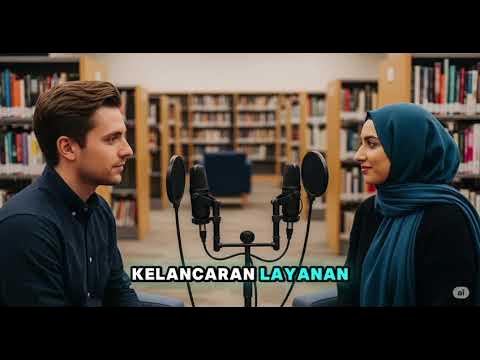P3 - Elemen Menghasilkan Karya dan Tindakan yang Orisinal
Summary
TLDRThe script discusses a creative dimension workshop where students are encouraged to use local coastal resources to present ideas for a village festival. It highlights the importance of fostering creativity in students by allowing them to explore their interests and passions, such as cooking with local seafood or creating musical instruments from recycled waste. The narrative emphasizes the role of educators in guiding students to appreciate and evaluate their creative works, and to consider the impact of their actions on others and the environment.
Takeaways
- 📚 The script discusses the importance of creative dimensions and generating original ideas.
- 🌟 It emphasizes the use of renewable resources, like coastal resources, for creative projects.
- 🍽️ Students are encouraged to create original works and actions, such as cooking with local fish recipes.
- 🎶 Another group proposes making musical instruments from recycled waste, inspired by the pollution on beaches.
- 🤔 The script highlights the importance of critical thinking in evaluating the use of resources and the impact of creations.
- 👩🏫 Teachers are advised to provide themes and allow students the freedom to choose the form of their creative work.
- 🧠 Creativity can be driven by personal interests, emotions, or the desire to solve problems.
- 🌱 The script suggests that creative works can be appreciated and developed through self-evaluation and peer feedback.
- 📈 It outlines the developmental stages of creativity in students from early childhood to high school.
- 🏫 Teachers play a crucial role in fostering creativity by avoiding rigid instructions and encouraging exploration.
- 🌐 The script concludes by emphasizing the role of educators in supporting students to produce original works and actions.
Q & A
What is the main theme of the creative session described in the transcript?
-The main theme of the creative session is to explore and generate original works and actions using the resources available around the coastal village for a festival.
What is the role of the teacher, Bu Marta, in the creative process described?
-Bu Marta plays a facilitative role, providing a broad theme and allowing students the freedom to choose the form of their creative work. She also appreciates the students' efforts and encourages them to evaluate and improve their creations.
What are the students, Satya and Daya, planning to do for the coastal village festival?
-Satya plans to use local marine resources, specifically fish, to create various creative fish dishes. Daya plans to make musical instruments from recycled waste found on the beach to raise awareness about marine pollution.
Why did Daya choose to use waste as the material for the musical instruments?
-Daya chose to use waste because they were saddened by the amount of trash on the beach and wanted to transform it into something useful and beneficial, thereby addressing the issue of marine pollution.
What challenges did Daya's group face when creating musical instruments from waste?
-The challenge was to create instruments that produce different sounds using various types of waste, such as cans and bottles filled with different materials to alter their tones.
How does Bu Marta respond to the students' creative ideas?
-Bu Marta responds with openness and appreciation, encouraging the students to think differently about resources and to take risks in their creative process.
What is the significance of the students' creative works in the context of the coastal village festival?
-The students' creative works are significant as they not only showcase their talents and interests but also address local issues like marine pollution and promote sustainable use of resources.
How does the transcript suggest that creativity can be fostered in educational settings?
-The transcript suggests fostering creativity by providing themes, encouraging exploration and expression based on interests, and allowing students to appreciate and critique their own and others' works.
What are some ways teachers can support students in developing their creative skills as mentioned in the transcript?
-Teachers can support students by avoiding rigid instructions, facilitating discussions, encouraging alternative choices, and providing opportunities for students to evaluate their own work and consider its impact.
How does the transcript describe the progression of creative development in students?
-The transcript describes a progression from simple exploration and expression in early education to more complex evaluation and consideration of personal and social impacts in higher education.
What is an example of how creativity can be applied in different educational stages as described in the transcript?
-In early childhood education, creativity can be applied through imaginative play, such as pretending to be animals and mimicking their behaviors. In primary school, students can create presentations or dioramas to reflect on historical events. In high school, students can engage in projects that analyze social changes and evaluate their personal and broader impacts.
Outlines

This section is available to paid users only. Please upgrade to access this part.
Upgrade NowMindmap

This section is available to paid users only. Please upgrade to access this part.
Upgrade NowKeywords

This section is available to paid users only. Please upgrade to access this part.
Upgrade NowHighlights

This section is available to paid users only. Please upgrade to access this part.
Upgrade NowTranscripts

This section is available to paid users only. Please upgrade to access this part.
Upgrade NowBrowse More Related Video

Musyawarah Masyarakat Desa

Layanan Perpustakaan: Mengenal sistem layanan perpustakaan

Potret Nelayan Pulau Buton di Pesisir Sulawesi Tenggara | MENJADI INDONESIA

Elemen Menghasilkan Gagasan yang Orisinal | Dimensi Kreatif

SIMULASI MENGAJAR: PEMBELAJARAN BERDIFERENSIASI, GURU PENGGERAK TABANAN, SD NEGERI 1 TUNJUK

Introducing one of the Lateral Thinking tools: Random Entry
5.0 / 5 (0 votes)